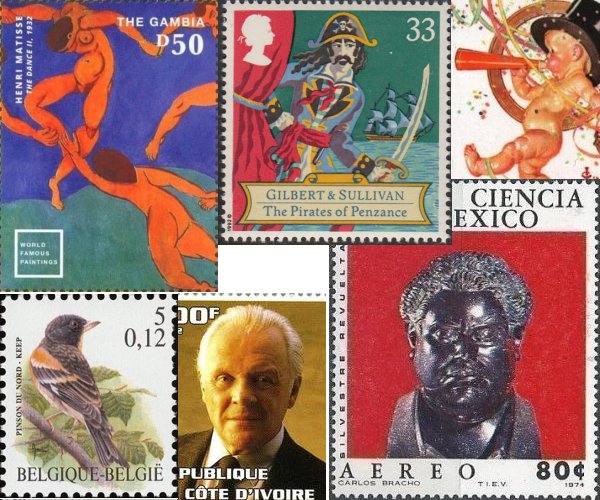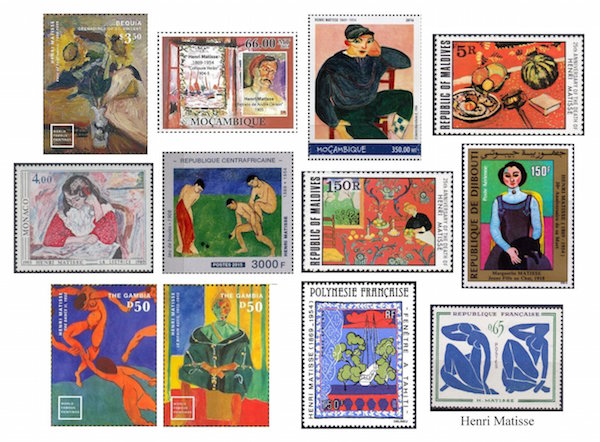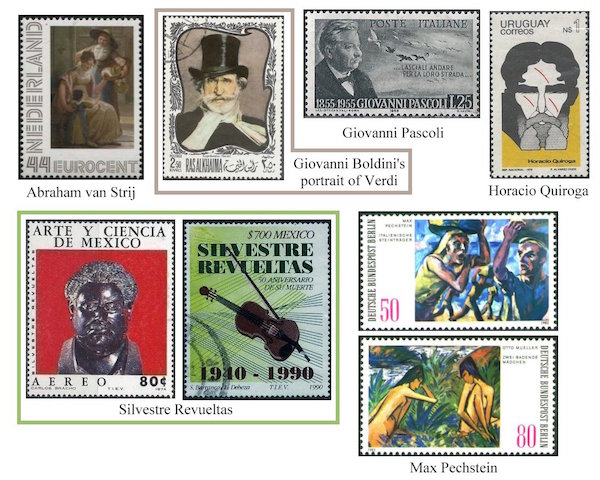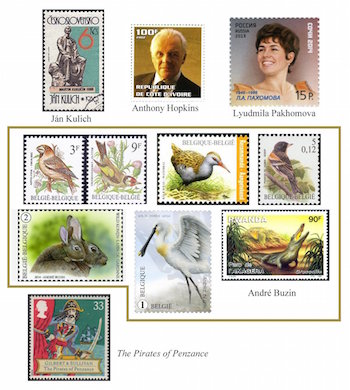The Arts on Stamps of the World — December 31
An Arts Fuse regular feature: the arts on stamps of the world.

By Doug Briscoe
On this final day of The Arts on Stamps of the World it’s gratifying to be able to present another big spread of stamps showing paintings by a master, in this case, Henri Matisse (31 December 1869 – 3 November 1954). To begin with the earliest Matisse on a stamp, we have Vase of Sunflowers (1898) at upper left. Right next it, on a stamp from Mozambique, paintings from just seven years later manifest an entirely different style: a detail from Open Window (or Collioure Summer, 1904-05) is paired with Portrait of André Derain (1905). Matisse and Derain worked together that year at Collioure. The Young Sailor II, Still Life with Red Rug, and The Reader (Portrait de Marguerite) were all painted in 1906. From 1908 come Game of Bowls and The Dessert: Harmony in Red (The Red Room). Young Girl with Cat comes from 1910, as does the second version of Matisse’s famous piece, The Dance, on a stamp from Gambia. That stamp’s companion shows Le Rifain assis (Seated Riffian, 1912-13), and the remaining two stamps, from France and French Polynesia respectively, offer Window in Tahiti (1936) and The Blue Nudes (1952), the latter from the series of goauche-painted cut-outs Matisse made late in life. Incidentally, Boston’s Museum of Fine Arts houses many Matisses, including Nude (Carmelina) of 1904.

The Netherlandish painter Abraham van Strij (31 December 1753 – 7 March 1826) was born and died in Dordrecht. His father, brother, and son were also painters, and Abraham was at one point the director of the Guild of St. Luke. On the Dutch stamp we can see a detail from his genre piece A Cherry Seller at the Door (1816).
Nearly a century on we come to the Italian painter Giovanni Boldini (31 December 1842 – 11 July 1931). Born in Ferrara, he devoted six years to art studies in Florence, visited London, where he enjoyed considerable success with his portraits, and resided in Paris from 1872. He was a friend of Degas and was made a member of the Legion of Honor in 1899. A solo exhibit was given in New York in 1897, and his work appeared at the Venice Biennale in various years. No stamp is devoted to him, but his Portrait of Verdi (1886) has been used on a stamp for the composer from Ras al Khaima. Boldini appears as a character in a recent ballet called Franca Florio, regina di Palermo (2007) by Italian composer Lorenzo Ferrero. Donna Franca Florio was a Sicilian aristocrat whose portrait was painted by Boldini in 1924.

Boldini’s compatriot, contemporary, and namesake Giovanni Pascoli (December 31, 1855 – April 6, 1912) was a poet. In childhood he lost both parents and three siblings, losses that colored his world view and are reflected in his first important collection, Myricae (1891). At the University of Bologna he became a student of Giosuè Carducci, whom he would later succeed as as professor of Italian literature. Pascoli began his professional life as a teacher, but his success as a poet enabled him to buy a house in Castelvecchio, where he lived with his sister. Pascoli wrote in both Italian and Latin as well as translating poetry from the English and has given composers the impetus for a number of songs, including examples by Riccardo Zandonai, Guido Fano, and Ferenc Farkas.
Although also a poet, the Uruguayan Horacio Quiroga (31 December 1878 – 19 February 1937) was best known as a short story writer. (There are also two novels and a play.) Inspired to some extent by Poe, Quiroga often dealt with supernatural or bizarre elements in his stories. This tendency may have been exacerbated by a succession of tragedies in 1901, when he lost two sisters to cholera and accidentally shot and killed his dear friend and fellow writer Federico Ferrando. Despondent, Quiroga moved from Uruguay to Buenos Aires to join another sister, and his excursions into the Argentine jungle would enlarge the sense of mystery already present in his stories. His first book, a poetry collection, had appeared while he was still in Uruguay, but it was a concentration on short stories, many of them horror stories but also some charming children’s pieces, that brought him fame by 1907. After yet another tragedy, the suicide of his wife, Quiroga wrote the Kipling-inspired Jungle Tales (1918) for his children. He, too, took his own life on learning that he had incurable prostate cancer.
Let’s remain in Latin America for one of the finest Mexican composers, Silvestre Revueltas (1899 – October 5, 1940), who was born in Durango. After studies in Mexico City, Austin, Texas, and Chicago, he gave violin recitals. Carlos Chávez, who, like Revueltas, did much to support new music in Mexico, invited him in 1929 to become assistant conductor of the National Symphony Orchestra of Mexico, which office Revueltas filled until 1935. A greater concentration on composing began around this time, but after his return from the Spanish Civil War, his lack of success led to poverty and alcoholism, which hastened his death at the age of 40 on the same day that his ballet El renacuajo paseador was premièred. Mexico has issued two stamps in his honor, one in 1974 and another in 1990.
December 31 is also the birthday of German expressionist painter Max Pechstein (1881 – June 29, 1955). He was born at Zwickau and studied in Dresden, where he met Erich Heckel and became the only member of the group Die Brücke to have had formal art training. Inspired by Van Gogh and (today’s fellow birthday boy) Matisse, he produced fauvist and primitivist canvases. Naturally he fell afoul of the Nazis, who displayed sixteen of his pieces as examples of “entartete Kunst” in the notorious 1937 Munich exhibition. Pechstein had been a professor at the Berlin Academy until 1933 and was reinstated in 1945. The stamps show Italian Stone Carriers and Two Bathing Girls. Pechstein was also a prolific printmaker.

Back in May we saw a stamp portraying Slovakian sculptor Ján Kulich’s statue of the writer Martin Kukučín, and we must trot it out again for Kulich’s birthday today, as he seems to have no other. Born in this day in 1930, Kulich made public statues and medallions of noted figures, including Lenin, turning later in life to religious subjects. He died just recently, on 15 March 2015.
Two great British actors, Anthony Hopkins and Ben Kingsley, were both born on 31 December, Hopkins in 1937, Kingsley in 1943. Alas, only Sir Anthony appears on any stamps, not Sir Ben.
I find it entirely fitting that on our last day, AoSotW should present an artist from a previously unvisited category, ice dancing! Lyudmila Pakhomova (31 December 1946 – 17 May 1986), who died of leukemia at 39, claimed Olympic gold in 1976 with partner Alexandr Gorshkov.
Born on precisely the same day as Pakhomova was Belgian artist André Buzin, who paints animals and flowers and has produced many beautiful designs for stamps, notably birds. From 1985 come his representations of the grosbeak and European goldfinch, while a stamp from just this year shows the water rail. I offer a small selection of Buzin’s other work on stamps.
December 31 also marks the anniversary of the first performance (in New York City!) of Gilbert and Sullivan’s The Pirates of Penzance (1879).

We have no stamp for songwriter Jule Styne (December 31, 1905 – September 20, 1994), who gave us such memorable tunes as “Let It Snow! Let It Snow! Let It Snow!” (1945), “Diamonds Are a Girl’s Best Friend” (from Gentlemen Prefer Blondes, 1949), the Academy Award-winning “Three Coins in the Fountain” (1955), “Everything’s Coming Up Roses” (from Gypsy, 1959), and “Don’t Rain on My Parade” from Funny Girl (1964).
New Year stamps have for a long time been a common theme in philately. Here are examples from Russia (1966), France and the US (2000), Portugal (1968), and Hungary (1964). Happy new year to all!
This concludes The Arts Fuse’s year-long presentation of The Arts on Stamps of the World. My thanks to William Marx for allowing this feature to spread its wings and to the many (well, the handful) of people who responded so warmly and favorably. The blog was never intended to be—indeed, couldn’t be—all-inclusive, and many artists fell by the wayside. My apologies if your favorites were among them.
Editor’s Thank You Note: My and our readers deep gratitude for this unfailingly informative and gloriously beautiful daily feature, an ambitious venture that could only be pulled off by the indefatigable Doug Briscoe. The Arts Fuse was proud to host this unique cultural resource, a fascinating exploration of the history of the arts around the world through its stamps. (Has anyone, anywhere else, done anything like it?) The year has ended, but this will not conclude Doug’s appearances on The Arts Fuse. He will be back for a monthly column in which he takes another look at stamps, arts, and the world. — Bill Marx
A graduate of the University of Massachusetts with a B.A. in English, Doug Briscoe worked in Boston classical music radio, at WCRB, WGBH, and WBUR, for about 25 years, beginning in 1977. He has the curious distinction of having succeeded Robert J. Lurtsema twice, first as host of WGBH’s weekday morning classical music program in 1993, then as host of the weekend program when Robert J.’s health failed in 2000. Doug also wrote liner notes for several of the late Gunther Schuller’s GM Recordings releases as well as program notes for the Boston Classical Orchestra. For the past few years he’s been posting a Facebook “blog” of classical music on stamps of the world, which has now been expanded to encompass all the arts for The Arts Fuse.
